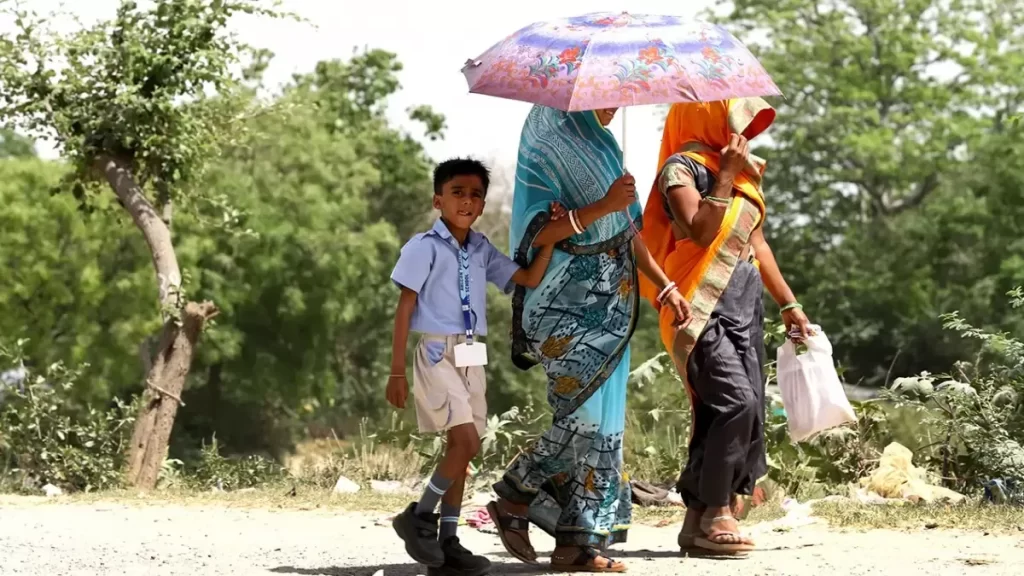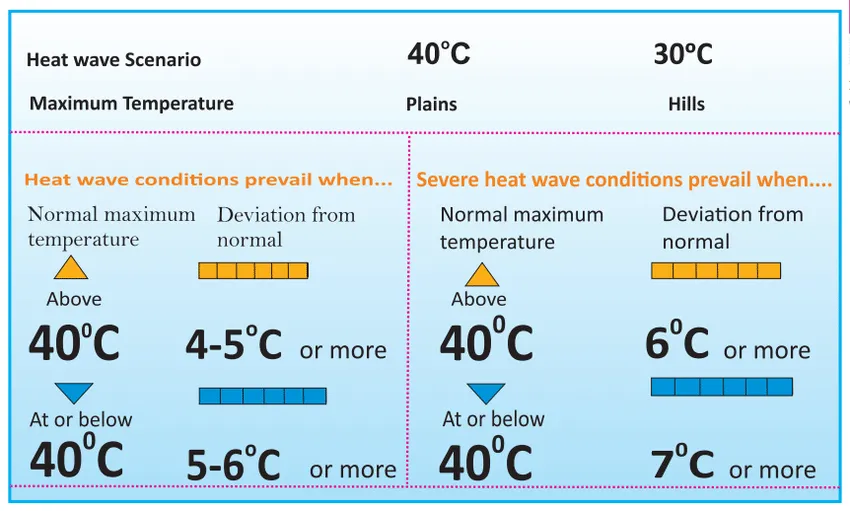Ref : https://indianexpress.com/article/explained/explained-climate/heatwaves-april-9297681/
Why in the news?
In April, India has witnessed unusually high temperatures. According to the India Meteorological Department (IMD), heat waves like conditions have been observed either in small pockets or across significantly large areas across the country during the first 26 days of the month. The southern peninsular region and the southeastern coast have been particularly hard-hit. The northern plains have not yet experienced heat waves this season.

What are Heat Waves?
- Heat waves refer to prolonged periods of extremely hot weather.
- They can have negative effects on human health, the environment, and the economy.
- India, being a tropical country, is particularly susceptible to heat waves, which have been increasing in frequency and intensity.
Which areas in India are prone to Heat Waves?
- The Central, North, and Peninsular regions of India, are known as the Core Heatwave Zone (CHZ).
- Heatwaves typically occur in these areas during the summer season, spanning from March to June, with occasional occurrences in July.
Rajasthan, Punjab, Haryana, Chandigarh, Delhi, Western Madhya Pradesh, Uttar Pradesh, Chhattisgarh, Odisha, Vidarbha in Maharashtra, parts of Gangetic West Bengal, coastal Andhra Pradesh, and Telangana are identified as the most heatwave-prone states or regions.
Criteria for Declaring Heat Wave in India:
Plains and Hilly Regions
- Heat wave in India is declared if the maximum temperature of a station reaches at least 40°C or more for Plains and at least 30°C or more for Hilly regions.
- Departure from normal temperature determines the severity:
- Heat Wave: Departure from normal is between 4.5°C to 6.4°C.
- Severe Heat Wave: Departure from normal is greater than 6.4°C.
- Actual maximum temperature also plays a role:
- Heat Wave: When actual maximum temperature is at least 45°C.
- Severe Heat Wave: When actual maximum temperature is at least 47°C.
- If these conditions are met in at least two stations within a Meteorological subdivision for at least two consecutive days, a heat wave is declared on the second day.

Coastal areas
- If the maximum temperature deviates by 4.50°C or more from the normal range, a heat wave might be indicated, provided that the actual maximum temperature reaches 37°C or higher.
Fatality
- Elevated temperatures alone are not inherently fatal. When high temperatures coincide with high humidity, known as the wet bulb temperature, heatwaves become lethal.
- Increased moisture in the air impedes sweat evaporation and hinders the body’s ability to cool down. This leads to a rapid rise in internal body temperature that can result in fatalities.
Causes
- Global warming is a primary contributor to heatwaves in India, causing long-term increases in Earth’s average temperature.
- This phenomenon leads to higher temperatures and alterations in weather patterns, culminating in heatwaves.
- Rapid urbanisation fosters the “urban heat island effect” where cities with dense populations and concrete structures retain more heat. This leads to increased temperatures during heatwaves.
- The El Niño effect, characterised by warming Pacific Ocean temperatures, influences global weather patterns, affecting temperature, rainfall, and wind distribution worldwide.
- El nino and cyclones have created sweltering hot conditions and heatwaves during April in India.
Impacts
- Health Impact:
- Rapid spikes in heat can disrupt the body’s temperature regulation, leading to various heat-related illnesses like heat cramps, heat exhaustion, heatstroke, and hyperthermia.
- Heat-related deaths and hospitalizations can occur suddenly or with a delayed onset.
- Impact on Water Resources:
- Heatwaves worsen water scarcity in India, causing water bodies to dry up, reducing water availability for agriculture and daily use, and intensifying competition for water.
- This can trigger conflicts over water resources, alter irrigation methods, and affect industries reliant on water.
- Impact on Energy:
- Heatwaves elevate the demand for electricity to power cooling systems, straining power grids and potentially causing blackouts.
- Disruptions in electricity supply can disrupt economic activities, diminish productivity, and disproportionately affect vulnerable communities lacking reliable access to cooling during heatwaves.
Way Forward
- Introduction of Heat Waves Action Plan:
- Due to the adverse impacts of heatwaves, comprehensive disaster adaptation strategies and robust disaster management policies are necessary in heatwave-prone areas to mitigate their effects.
- Preventable deaths resulting from heat waves underscore the urgency for the government to prioritise the development of a long-term action plan aimed at safeguarding human lives, as well as those of livestock and wildlife.
- Emphasis on Disaster Risk Reduction:
- Effective implementation of the Sendai Framework for Disaster Risk Reduction 2015-30, with the state taking a leadership role and sharing responsibilities with other stakeholders, is imperative.
- Implementation of Climate Action Plans:
- Full implementation of the National Action Plan for Climate Change (NAPCC) is essential for fostering inclusive growth and ecological sustainability.
- Nature-based solutions should be integrated into strategies not only for addressing climate change-induced heat waves but also ensuring ethical practices and promoting intergenerational justice.
- Sustainable Cooling Strategies:
- Passive cooling technology, which involves naturally ventilated buildings, presents a crucial alternative for combating the urban heat island effect in residential and commercial structures.
- The IPCC’s AR6 highlights the adaptation of ancient Indian building designs utilising this technology to modern facilities in the context of global warming.
- Heatwave Mitigation Measures:
- Mitigating heat-related fatalities can be achieved through effective interventions such as ensuring access to water, oral rehydration solutions (ORS), and shade, particularly in public areas.
- Additionally, implementing flexible working hours in workplaces and making special arrangements for outdoor workers are vital measures.
- Importance of Proactive Local Administration:
- Proactive implementation by vigilant local administration, overseen by higher authorities, is crucial for the success of these mitigation efforts.


Leave a Reply
You must be logged in to post a comment.